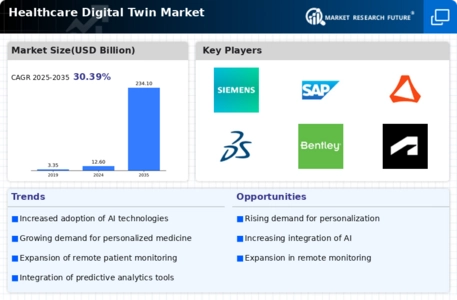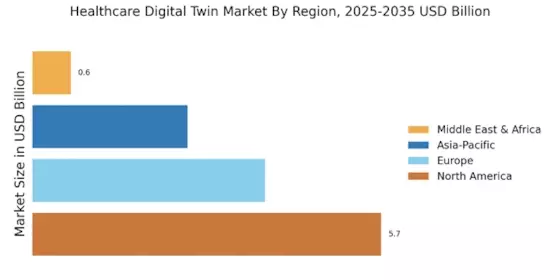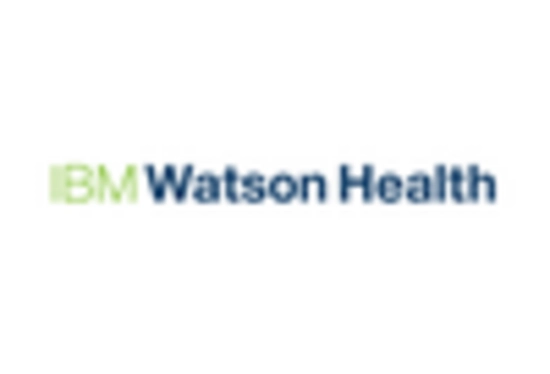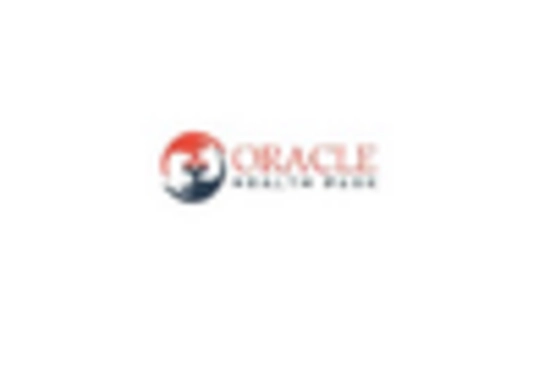Advancements in Simulation Technologies
Advancements in simulation technologies are playing a pivotal role in the Healthcare Digital Twin Market. These technologies allow for the creation of highly detailed and accurate digital representations of patients, which can be used for training, treatment planning, and outcome prediction. The increasing sophistication of simulation tools is enabling healthcare professionals to visualize complex medical scenarios, thereby improving clinical decision-making. As simulation technologies continue to evolve, the Healthcare Digital Twin Market is expected to benefit from enhanced capabilities and applications. The market for healthcare simulation is anticipated to grow significantly, indicating a promising future for digital twin applications in clinical settings.
Growing Focus on Value-Based Care Models
The shift towards value-based care models is influencing the Healthcare Digital Twin Market. Healthcare providers are increasingly held accountable for patient outcomes, which necessitates the use of innovative technologies to enhance care delivery. Digital twins can provide insights into patient health trajectories, enabling providers to tailor interventions that improve outcomes and reduce costs. This focus on value-based care is likely to drive investments in digital twin technologies, as they offer the potential for more effective and efficient healthcare solutions. The value-based care market is projected to expand rapidly, suggesting that the Healthcare Digital Twin Market will experience growth as providers seek to align with these emerging models.
Regulatory Support for Digital Health Innovations
Regulatory bodies are increasingly recognizing the potential of digital health innovations, which may bolster the Healthcare Digital Twin Market. Governments are implementing frameworks that support the development and deployment of digital twin technologies in healthcare. For instance, the FDA has introduced guidelines for software as a medical device, which could facilitate the approval process for digital twin applications. This regulatory support is crucial, as it encourages investment and innovation in the sector. The market for digital health is expected to grow at a compound annual growth rate (CAGR) of 25% through 2025, suggesting that favorable regulations could significantly enhance the Healthcare Digital Twin Market.
Integration of IoT in Healthcare Digital Twin Market
The integration of Internet of Things (IoT) technologies into the Healthcare Digital Twin Market appears to be a driving force. IoT devices facilitate real-time data collection from patients, enabling the creation of accurate digital replicas. This integration enhances patient monitoring and management, leading to improved health outcomes. According to recent estimates, the IoT healthcare market is projected to reach USD 500 billion by 2025, indicating a robust growth trajectory. The synergy between IoT and digital twins allows for predictive analytics, which can potentially reduce hospital readmission rates and optimize treatment plans. As healthcare providers increasingly adopt IoT solutions, the Healthcare Digital Twin Market is likely to experience significant expansion.
Rising Demand for Predictive Analytics in Healthcare
The growing demand for predictive analytics in healthcare is a notable driver for the Healthcare Digital Twin Market. Healthcare providers are increasingly seeking ways to leverage data for better decision-making and patient outcomes. Digital twins enable the simulation of patient responses to various treatments, allowing for personalized care strategies. The predictive analytics market in healthcare is projected to reach USD 34 billion by 2025, reflecting a strong interest in data-driven solutions. This trend indicates that healthcare organizations are likely to invest in digital twin technologies to enhance their predictive capabilities, thereby driving growth in the Healthcare Digital Twin Market.


















Leave a Comment